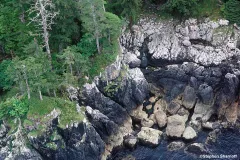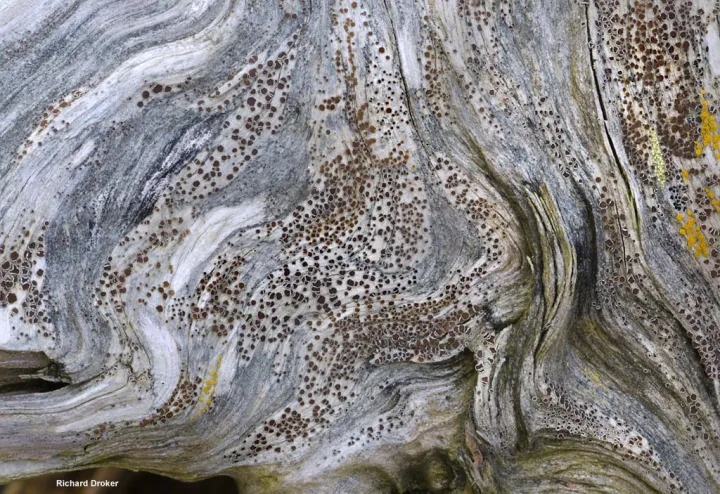Seaside Lichens

Very few plant species can survive close to the ocean, where pounding surf fills the air with tiny salt crystals. Too much salt is not good for us, and it is not good for most plants. When you think about it, the land side of the seashore is a really harsh environment, with crashing waves, salty spray and a constantly moving shoreline. Living things need special adaptations to survive there.
One group of organisms called lichens, however, have made a specialty of surviving in difficult environments. In places like deserts and mountaintops where not much else can live, you will often find thriving communities of lichens. In fact, one species of lichen was left in the vacuum of space outside the International Space Station for a year and a half and managed to grow and reproduce when it was brought back inside.
It should not be a surprise, then, that certain lichens have found a way to adapt to the salt-heavy environment of the seashore. As a matter of fact, these salt-loving (halophilic) lichens will live nowhere else.
But first, what is a lichen anyway? A lichen is a partnership—a symbiosis—between a fungus and another organism (an algae or bacteria, sometimes both) that can convert sunlight to energy using photosynthesis. The green partner provides the energy, which fungi can’t produce on their own, and the fungal partner provides a place for the green partner to grow. Lacking roots, lichens get their moisture and nutrients from the air or from whatever washes over them. There are more than 15,000 species worldwide—they can be found wherever the air is clean. Most people know them as gray, yellow or green patches on trees or rocks.
A good place to start looking for lichens is a rocky seashore because they often form obvious patterns on rocks. Look for horizontal bands or zones of color—often black, yellow and orange. These represent different species of lichen that have adapted to the conditions at different heights above sea level. Lichens near the top of a rocky shoreline—typically bright orange or white—do not get very wet, but do occasionally get sprayed with salt and bird droppings. Lichens just above the level of high tide get consistently sprayed with water but are completely immersed only during storms and they are typically gray, brown or yellow. Lichens between the high and low tide marks are submerged on a regular basis but also get exposed to the sun regularly—they form the black zone.
Each of these unique habitats supports a different community of lichens. Most conspicuous are the bright orange patches of the sunburst lichen (Xanthoria parietina) and seaside firedot (Caloplaca scopularis). For the extensive areas of black lichen often seen near the water line, it is sometimes hard to believe that you are looking at a living thing rather than the rock itself. After offshore oil spills, these black lichens (mostly the sea tar lichen, Verrucaria maura) are sometimes mistaken for petroleum, and cleanup crews have to be instructed not to try to scrub them from the rocks. A tiny lichen species lives on the shells of barnacles (Collemopsidium halodytes) growing on rocks in the intertidal zone. There are even species of lichen that are found only on driftwood. They are not always easy to see—to the naked eye they might look like a dark stain on the otherwise sun-bleached surface of the driftwood. But, if you use a magnifying lens you can see the tiny disk-like or elongated fruiting bodies that contain the spores of the fungal partner. Driftwood lichens like the rim lichen (Lecanora xylophila) and wood script (Xylographa opegraphella) are never found far from the sea.
For most living creatures, it’s not the easy-going “day at the beach” that we enjoy so much. Next time you visit the seashore, take a moment to think about the challenges facing any organism that dwells there among salt, sun and water. Then look around to see if you can spot some of these ocean-loving lichens that have discovered so many unique ways to adapt.



